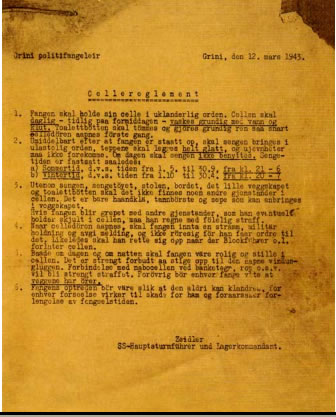



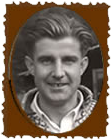 Claes Berg Claes Berg and Arild had been friends since childhood. With a couple of other friends they organised one of the many groups that printed and distributed illegal newspapers in Oslo. One of these friends had a younger brother who, though only 16, had also become involved in some kind of resistance. He was too young to realise the importance of security and to understand the dangers involved. He shared a room with his elder brother and one night Gestapo officers stormed in as the brothers slept. The elder brother was certain that they had come for him but it was the 16 year old they arrested. After repeated interrogations and torture, the young man disclosed Claes’ identity.
Claes Berg Claes Berg and Arild had been friends since childhood. With a couple of other friends they organised one of the many groups that printed and distributed illegal newspapers in Oslo. One of these friends had a younger brother who, though only 16, had also become involved in some kind of resistance. He was too young to realise the importance of security and to understand the dangers involved. He shared a room with his elder brother and one night Gestapo officers stormed in as the brothers slept. The elder brother was certain that they had come for him but it was the 16 year old they arrested. After repeated interrogations and torture, the young man disclosed Claes’ identity.
Immediately after the arrest, Claes, Arild and the others in the group went into hiding. They continued to print and distribute newspapers but avoided their previous haunts and took painstaking precautions before contacting their families. Claes’ mother hung a towel in the kitchen window if the coast was clear but one day the police were waiting anyhow and they overpowered him at the door of the apartment. He was allowed to go in to get some other clothes and under the pretext of giving his mother a kiss he whispered, “Ring Arild”. She did, giving Arild an opportunity to flee to Sweden.
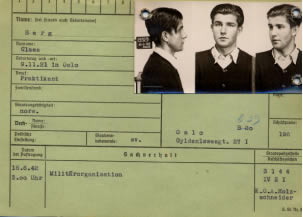 Claes was taken first to the prison at Bredvedt, and then to Møllergaten 19, the feared Gestapo headquarters in Oslo. From the questions and treatment he received, Claes realised that they had no real evidence against him and, after a few weeks, thinking that Arild would, by now, be in Sweden, he ‘gave’ his interrogators Arild’s name. After this he was sent to the less onerous prison camp at Grini. He soon realised that he would probably be sent to Germany so he began to brush up on his German. The last thing he remembers from Grini is that the guards became more cheerful and amenable when they heard the erroneous news that Stalingrad had fallen to the Germans. Claes was sent to Sachsenhausen in 1943.The first leg of the journey, from Oslo to Stettin, was on the infamous prison ship ‘Donau’. We talked to Claes several times in 2006 and early in 2007.
Claes was taken first to the prison at Bredvedt, and then to Møllergaten 19, the feared Gestapo headquarters in Oslo. From the questions and treatment he received, Claes realised that they had no real evidence against him and, after a few weeks, thinking that Arild would, by now, be in Sweden, he ‘gave’ his interrogators Arild’s name. After this he was sent to the less onerous prison camp at Grini. He soon realised that he would probably be sent to Germany so he began to brush up on his German. The last thing he remembers from Grini is that the guards became more cheerful and amenable when they heard the erroneous news that Stalingrad had fallen to the Germans. Claes was sent to Sachsenhausen in 1943.The first leg of the journey, from Oslo to Stettin, was on the infamous prison ship ‘Donau’. We talked to Claes several times in 2006 and early in 2007.
Claes Berg opens the door to his Oslo apartment, looks at his watch, and says, “You are precise”. Punctuality is obviously important to him. It is two o’clock on a cold, snowy day in January. Claes continues to speak in English. I say that he can just as well speak Norwegian but no, he prefers English. He tells me that he has lived alone in this large apartment since his wife died many years ago. It is his childhood home. He came here when he was seven. The square in front of the apartment bears the name of his father, an architect who was Oslo’s first official “Cultural Heritage Manager.” Claes has been an active cross-country and slalom skier, and a competitive sailor for most of his life. He still takes long walks but admits to having slowed down somewhat lately He shows me a photograph and tells me proudly that his three children are just about perfect. This gives me the opportunity to ask him if his children know about his experiences during the war, “They know the broad picture but I never told them all the details, partly because they were already biased against Germany after the occupation of Norway and I didn’t want to add to their prejudices.”
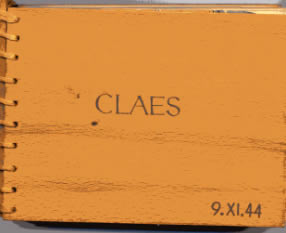 As we sit down he opens a box and hands me what looks like two blocks of wood, held together by raffia through small holes on the left. ‘Claes’ and ‘9,X1.44’ – his birthday – are burned into the wood. Inside, on stiff cardboard, are birthday greetings, drawings, caricatures, and cartoons – all dedicated to Claes in tiny handwriting – a fitting memento. On one page, rather incongruously, a sketch of a well-worn boot with a birthday greeting fastened to a lace. The text underneath reads “GOOD LUCK FROM THOSE WHO “LÄUF” AND… On the following page the text continues, “…from those who are supposed to.” Above this text are the names of 8 Englishmen. Claes explains that within the camp, the Germans had constructed several paths which had surfaces of various materials.
As we sit down he opens a box and hands me what looks like two blocks of wood, held together by raffia through small holes on the left. ‘Claes’ and ‘9,X1.44’ – his birthday – are burned into the wood. Inside, on stiff cardboard, are birthday greetings, drawings, caricatures, and cartoons – all dedicated to Claes in tiny handwriting – a fitting memento. On one page, rather incongruously, a sketch of a well-worn boot with a birthday greeting fastened to a lace. The text underneath reads “GOOD LUCK FROM THOSE WHO “LÄUF” AND… On the following page the text continues, “…from those who are supposed to.” Above this text are the names of 8 Englishmen. Claes explains that within the camp, the Germans had constructed several paths which had surfaces of various materials.
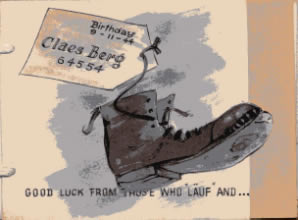 Prisoners, including these Englishmen, were made to walk up and down these paths wearing different types of boots – to test of the boots’ quality. Claes continues, “It was a form of punishment, they walked and walked for hours at a time with little sustenance. They lived in another part of the camp but came to me to get extra food. The writing in the book made it clear that without the additional rations they would not have lasted very long but Claes admits that his efforts had been in vain, “these particular prisoners were executed by the Germans towards the end of the war.”
Prisoners, including these Englishmen, were made to walk up and down these paths wearing different types of boots – to test of the boots’ quality. Claes continues, “It was a form of punishment, they walked and walked for hours at a time with little sustenance. They lived in another part of the camp but came to me to get extra food. The writing in the book made it clear that without the additional rations they would not have lasted very long but Claes admits that his efforts had been in vain, “these particular prisoners were executed by the Germans towards the end of the war.”
“There was also a Russian prisoner who was especially ill-treated even though the Germans didn’t know that his father was a high-ranking communist leader in Moscow. The father must have been important because when the camps were liberated, he managed to get his son sent straight to Moscow. All the other Russian prisoners were shipped off to Siberia. I gave him extra bread and he is still alive and well and living in Russia. I visited him after the war and he came to Norway. His biggest surprise here was that for the first 10 days he didn’t see a single policeman. Finally we had to seek one out in Bergen just to convince him that we really did have a police force in Norway.”
I ask how he could give them extra food and he replies, “Well I was lucky. From an early date I got food parcels from Sweden. It was a complicated piece of luck. First my father had tried to send parcels from Norway but to no avail. I had an aunt in Stockholm. She tried to send parcels through regular channels but failed. However, she knew the owner of one of Sweden’s large industrial companies – a company that had contracts to deliver products to Germany. She approached the owner, a friend of hers, with the problem and he promised to help. Getting the Germans to accept ‘just small packages’, as part of the larger shipments of goods, was not easy but with a bit of bravado and hint of industrial blackmail, the friend prevailed.”
Claes says that he would never forget the first parcel that arrived: “…a higher ranking officer than we normally saw around our huts came to me followed by an orderly carrying a package. I was told to open it and inside was heaven: chocolate, butter, cakes, ‘Lucky Strike’ cigarettes … I had to sign for each item and was told to write and thank the relative who had sent the package – typical German thoroughness.” Claes smiles and adds that from then on he got a parcel about every other month – and that the same routine was followed each time.
In one letter home he had complained about the cold and in a parcel a few weeks later he found a Swedish military overcoat. The German officer and orderly, as usual, were in attendance and when they saw Claes in the overcoat they almost jumped to attention. “You are a Naval Admiral,” the officer exclaimed. Claes told them that he was far too young to be an admiral and that anyhow, he was a civilian. “But they didn’t seem to believe me and I’m convinced that from that day they treated me with a little more respect.” In the book, ‘Gestapo henter deg om natten’ (The Gestapo comes for you at night), the author tells how, one day, Claes managed to get out of his cell at Møllergaten 19 for a few hours. The alarm system had broken down in one of the cell blocks and the Germans had gone from cell to cell asking if anyone was an electrician. Claes was an engineer and not an electrician but he volunteered anyhow– and in fact, he fixed the problem. I suggested to Claes that maybe he had used the same technique to land his job in the motor repair workshop. “Well, not exactly, but my electrical skills came in very handy there.” he replied.
The motor repair workshop, where vehicles of all types, from motorcycles to tanks, were brought in for repair, was one of the satellites to the main camp. One day a German guard brought in a radio that didn’t work and asked around if anyone could repair it. Claes said he would try – and if he succeeded the price would be an extra ration of bread. The guard accepted, Claes fixed the radio and got his extra bread. This was the start of a regular ‘business’. Since there were no German civilian or military technicians in the neighbourhood, the word soon spread that Claes was the ‘radio fixer’ – and there was no shortage of faulty radios. “Fixing radios was the source of the extra rations that I could give, for example, to the Englishmen. There were those in my hut who thought I should share the extra food with them but we were in much better shape than many others in the camp.” A side benefit of the ‘business’ was that Claes always had a radio hidden away so that he could keep abreast of the war news.
At the workshop, damaged vehicles came in on numbered railway flatbeds. When the trains arrived, Claes and his crew were given a list of jobs to be done, each ‘job’ referring to a flatbed. On one occasion ‘the job’ was to repair something in a tank. He told his partner to climb aboard and try to get the engine started. Claes went into the turret where he found ammunition for the machine guns and the turret gun. The vehicle began to shake as the motor started up and they drove the half-track onto the ground. Claes remembers sitting in the turret with the guns and ammunition around him, and thinking that he could simply start moving and drive right out of the workshop, through the town into the countryside and away: “Nobody could have stopped me, there was no heavy artillery nearby, and small arms fire couldn’t penetrate the armour. The feeling of power was almost intoxicating – of course I did nothing – even in an armoured vehicle I couldn’t get far without food or money” he concluded. Radio repair was not the only activity in which Claes had to use a certain amount of bluff. The German in charge of the workshop, – not a very bright specimen according to Claes – had to write regular reports and, like many other Germans at that time, he could speak German better than he could write it. One day Claes saw a report that the supervisor was writing and he mentioned casually that it contained several mistakes. The supervisor asked to be shown the errors and corrected them without comment. The next week he asked Claes to read through the report he had just written and to correct any errors. “After a while I was writing the reports myself.” Claes smiles at the thought and adds, “Of course my German was really not all that good so I had to swot up on the grammar in the evenings.”
As a result of his ‘teaching’ post, Claes was again able to get extra food and special favours from the supervisor, for both himself and his crew: The situation got even better when, one day while the supervisor was absent from the workshop for a couple of hours, the ‘big brass’ of the camp arrived for an unexpected inspection The supervisor had a bad habit of leaving his service revolver and belt on his desk during working hours. He had done so on this day and Claes knew that if the inspection team found the revolver, the supervisor would be in serious trouble. Claes finished the story: “So I went into his office and quickly put the belt and revolver in a drawer. Just as the inspection was ending the supervisor returned. He literally turned white when he saw the high-ranking officers and looked nervously into his office. When the officers had left the supervisor asked what had happened to his revolver. I took him into his office and opened the drawer. After that he practically lived in my pocket.”
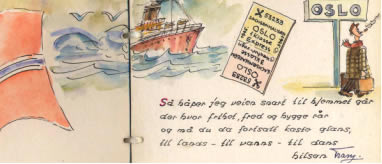 Claes explains that the Norwegians and Danes in the camp were a special group of prisoners, mostly educated, professional, or training to be professionals; doctors, teachers, lawyers. They quickly became leaders, trusted by both guards and guarded. They were trusted to the extent of being sent to other satellite camps, he gave an example: “A group of us were once sent to do some repairs at a camp on the other side of Berlin.
Claes explains that the Norwegians and Danes in the camp were a special group of prisoners, mostly educated, professional, or training to be professionals; doctors, teachers, lawyers. They quickly became leaders, trusted by both guards and guarded. They were trusted to the extent of being sent to other satellite camps, he gave an example: “A group of us were once sent to do some repairs at a camp on the other side of Berlin.
There were no trucks or cars available so we had to use local trains and busses. We wore our normal prison outfits and so we stuck out like sore thumbs among the civilians. What amazed me was the way most of the locals looked at us, some of them even said: ‘How could you be so stupid as to work against Hitler?’ We were looking forward to working at the other camp because we heard there were some females there – but we should have known better – the females were German guards, we got no help, little food and had to live by our wits most of the time.” Another of Claes’ friends was put in charge of an aircraft factory. “He lived an entirely different life to the rest of us” said Claes.
Just when I felt that Claes’ ‘wits’ had given him almost a ‘charmed’ life in this dreadful camp, his face clouds and he tells me about a couple of episode that were the stuff of nightmares: “I was one of the few who entered a gas chamber and lived to tell.” The prisoners who worked around the gas chambers, “Sonderkommandos” (Special Groups), usually Polish Jews, were themselves eliminated after a few months, either because they were too weak to continue or because the SS liquidated them – not wanting any survivors who knew about the ‘death camps.’ Again Claes was called upon to fix an electrical problem. The SS guard who accompanied him wouldn’t enter the gas chamber itself, but waited outside. Claes remembers: “The smell of gas hung in the air. The atmosphere was indescribable. It was dim, almost dark. I fixed the problem and got out as quickly as possible. Only when I got back to my hut did I realise that I might be in danger because of the SS ‘no survivor’ policy.”
“The second episode was just before liberation, when morale was low and sickness and death due to ill-treatment and malnutrition were at their highest. Each morning a special group of prisoners went around the barracks searching for and removing the bodies of those who had died in the night. I had a friend who, though not seriously ill, had difficulty in getting up and walking around. He lived in another hut and I went there one morning to see how he was but found that he had been taken away by the ‘body collectors’. ‘He wasn’t dead,’ one of the roommates said, ‘but the collectors insisted that he wouldn’t last another day.’ I rushed to the building where the bodies were placed after collection and found rows upon rows of corpses, eight to ten high. In one of the piles I saw my friend – his eyes were flickering and fingers moving”. Claes pointed this out to the guard and asked if he could remove the live body. But no, the bodies had been counted and if one was taken out it must be replaced – or the numbers wouldn’t add up. Finding a replacement body in a death camp was not difficult – and the switch was made.
The next day Claes’ friend was on his way back home thanks to Folke Bernadotte’s ‘White Buses.’ Claes himself followed soon afterwards and he tells of one final incident: “We had to change out of our prison garb and we were given strict orders not to take these with us. I was on a bus that stopped on the way to the exit and almost without thinking I got out, ducked into a hut, found a prison suit, and stuck it under my jacket. Claes was one of 2500 Norwegians in the camp when the buses arrived. He says, “Count Bernadotte was not thanked enough for his contribution to the release of Scandinavian prisoners.” Claes repeated this several times at a later meeting and related how Bernadotte had worked so hard and finally managed to persuade Himmler to allow the repatriation.
After some months of convalescence Claes began to take up the threads of his life again. His brother Knut, an art historian, had been sent to Germany to trace articles stolen by the Germans during the occupation. Most of the items were in the ‘Art ‘category but the list also included an entire factory! Knut could handle the art but had no technical knowledge and as Norway couldn’t afford to send an engineer, he suggested that, provided the government would pay for the transport, Claes would come and work for nothing: “A welcome break and a soft re-entry to civilian life.” as Claes put it. Yes, they found the factory.
The war had interrupted Claes’ education but he soon caught up and enrolled at Grenoble University to study engineering. “In later years my wife didn’t like me saying this,” he said, “but the years in Grenoble were the best years of my life.” After 4 years he came away from Grenoble with a lifelong passion for everything French; the food, the language, the people, and the country. Back in Norway he started working for a small engineering-import business that entailed much travelling. On his travels he found that many of the top managers in business had been either imprisoned or active in the resistance movement. The same was true of many government officials and politicians: the post-war Prime Ministers Einar Gerhardsen and Trygve Bratteli (who had lain in the bunk above Claes at one time) had both been incarcerated in Sachsenhausen. I suggested that perhaps their experiences and sufferings had hardened and strengthened them and that Norway had rewarded them with its trust – in politics and in business. He agreed to a certain extent but reminded me that there had been 20,000 members of Quisling’s National Socialist party during the war and that countless numbers of Norwegians profited from the war. In a strong voice he says, “We must never forget what happened. Next month I am going to a local school to tell a class of fifteen year olds about my experiences before they go on a guided tour to some of the concentration camps in Poland and Germany. I have done this before and I must admit that the students listened attentively. One of the teachers said afterwards that she had never before had pupils who listened so intensely and silently.”
Claes was obviously tired by now so I said we should take a break. He said that I hadn’t asked many questions but I explained that, like the pupils, all I had to do was listen intensely and silently.
From Claes Berg’s Birthday Book
Claes Berg – Epilogue
In December 2006 I visited Claes to return some photographs. His youngest son, one of his grandchildren and his brother were there. The adults had just started watching a film about the artists’ colony at Holmsbu, a small community on the coast about 60 kilometers from Oslo. I stayed to watch – the main character in the colony, Henrik Sørensen had played his part in the Resistance movement – and I had recently met his son at the Art Gallery in Holmsbu. Claes was not feeling too good that day but was obviously happy to have some of his family close by. They were going for a short walk before leaving for a family dinner at Claes’s daughter Jannike.
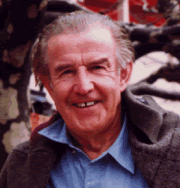 At the end of January 2007 I telephoned Claes and told him that we would be leaving for a month in Florida the next day. We agreed to meet again for another chat on our return.
At the end of January 2007 I telephoned Claes and told him that we would be leaving for a month in Florida the next day. We agreed to meet again for another chat on our return.
On Feb 2nd came an e-mail from Oslo with the sad news that Claes Berg had died. He had fought hard to hold onto life but I’m sure he did not fear death. Perhaps he had seen too much of it in those terrible years of his youth. His best friend, Arild, once told me that Claes was completely fearless: swishing down a steep slope on skis, making a tricky tack in a regatta, reaching a tough business decision. He remained so to the end.
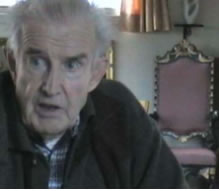 I had written to Jannike before leaving for Florida, asking some questions about her father. What follows is mostly based on her comments – about things that Claes mentioned only superficially during our several meetings.Arno Berg, a young architect, came to Norway from Sweden to study the ancient buildings at the Norwegian Folk Museum. Like many men before (and after) him, he found more than timbers and joints to interest him in Norway: he met his future wife and decided to settle in Oslo. This was an auspicious decision. Arno Berg became a significant figure in Oslo’s cultural life and in 1927 he was appointed director of ‘Selskabet for Oslo Byes Vel’ (The Company for the Preservation of Oslo). In 1956, when the City Council decided to establish the position of City Heritage Director, it seemed natural to choose Arno Berg to fill the post.
I had written to Jannike before leaving for Florida, asking some questions about her father. What follows is mostly based on her comments – about things that Claes mentioned only superficially during our several meetings.Arno Berg, a young architect, came to Norway from Sweden to study the ancient buildings at the Norwegian Folk Museum. Like many men before (and after) him, he found more than timbers and joints to interest him in Norway: he met his future wife and decided to settle in Oslo. This was an auspicious decision. Arno Berg became a significant figure in Oslo’s cultural life and in 1927 he was appointed director of ‘Selskabet for Oslo Byes Vel’ (The Company for the Preservation of Oslo). In 1956, when the City Council decided to establish the position of City Heritage Director, it seemed natural to choose Arno Berg to fill the post.
The Berg family, now including two boys Claes and Knut, was intimately connected with the artistic and cultural life in Oslo. Summer holidays were often spent at Holmsbu where the cultural life continued. The painter Oluf Wold Torne had ‘discovered’ Holmsbu in 1911 and many other artists and writers were attracted there by the tranquil fjord, the rounded, red, rocks and the sparkling light. By the time Henrik Sørensen bought a house there in 1929 Holmsbu had become one of the more important artists’ colonies in Scandinavia.
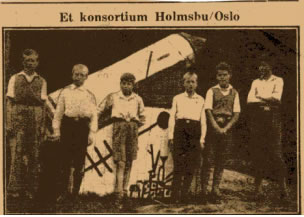 This was an inspiring atmosphere for the Berg family. Among Claes’ papers I found a newspaper cutting showing a group of boys at Holmsbu: Claes, Sven Oluf – Henrik Sørensen’s son – and 4 others, standing proudly around a model moon rocket. An inspiring atmosphere indeed – Sven Oluf became an Atomic Energy professor – was he the ‘brain’ behind the rocket?
This was an inspiring atmosphere for the Berg family. Among Claes’ papers I found a newspaper cutting showing a group of boys at Holmsbu: Claes, Sven Oluf – Henrik Sørensen’s son – and 4 others, standing proudly around a model moon rocket. An inspiring atmosphere indeed – Sven Oluf became an Atomic Energy professor – was he the ‘brain’ behind the rocket?
The impression was an almost bohemian existence. Jannike wrote: “Making money was not on my grand-parents agenda as opposed to Claes’ goal in life.” After Graduating in Electrical Engineering from the University of Grenoble in 1949 Claes went to Africa to work for a Belgian engineering company involved in construction work. He spent a couple of years there and then 18 months in Morocco before working in the Belgian Congo where he was involved in building houses. On the way home he flew across Africa, visited Egypt to see the Pyramids and Greece to see the Acropolis.
Claes never mentioned any of this to us when we were talking freely at home but, as Jannike says: “When we were young, he actually talked more about his experiences in Africa than Sachsenhausen!” We had heard from Arild that Claes had enjoyed his experiences in Africa and Jannike confirmed that – “he had a good time in Africa during the French and Belgian colonial times.” After working for an uncle who had a company representing a large Luxembourg concern, Claes started his own company in the early fifties. He became the Norwegian representative for Turtle Wax – a name that was synonymous with car polish in the 50’s and 60’s – and probably still is. (Yesterday, driving to Oslo from Asker, a shining, strikingly coloured car pulled out in front of us from a gas station – emblazoned over the whole body – Turtle Wax!). Claes also introduced Telma Brakes to Norway. This was a supplementary brake system for large trucks and busses that Claes had to both sell and install.
Probably because of his connections with the Luxembourg concern Claes was the Consul-General for Luxembourg from 1977 to 1997 and as a Francophile it was natural for him to establish a branch of his company in Paris. One of his successes there was importing motor saws for the lumber industry. After a few years the commuting between Oslo and Paris became too much and he sold the French company. The man who bought it remains a good friend – he had telephoned to Claes just a couple of days before I talked to him in January. The Norwegian company continues to thrive in the hands of Claes’ son Arno. Claes retired many years ago but he had an office in the company, made regular visits there until the summer of 2006 and attended the Christmas party in December.
I had asked Jannike if there were any special highlights in Claes’ business or private life and here’s what she wrote:
“Any highlights? On the negative side it was our mother’s illness. She married Claes young, had three children and discovered that she was manic depressive. This influenced their life tremendously but Claes was supportive until she died 30 years later. On the positive side, I think his highlights have been his three children and seeing us succeed in life, his own business and material success, which have given him the opportunity to travel, ski, sail, have a house in France etc. There are also his life-long friends, among them Arild, whom he met when they started first grade in 1928 at Uranienborg school. They are still very close, so their friendship reaches back almost 80 years. Claes has a big and very close-knit family and I feel that is one of his proudest contributions. He keeps referring to this and I think it is very important for him to know now, when his life is coming to an end, that he is leaving behind a big and happy family – the Berg Circus, as a French friend from University called it in the early 1950’s. The family atmosphere is still the same: Claes and his brother Knut, Knut’s wife Marcia, their six kids, in-laws and grandchildren.”
I also asked how Claes had been at home, thinking that, after his wartime experiences, with a wife who was ill, and a demanding job, raising a family may have been difficult for him. Not at all:
“How Claes was at home? He was a very good father for us, always interested in what we were doing, taking us out skiing, sailing and travelling. We went with him to ski in France and spent the summers in Spain. He was a globetrotter, fluent in several languages, very outgoing, curious and always active, much ahead of his time. Our friends became his friends. He has always encouraged us and supported us in sports, school and to get a good education and use our talents. He has always been very liberal.”
No wonder that one of the first things Claes had shown me was a photograph – “These are my children” he said, “They are just about perfect.”
Asker April 2007
Prison Regulations – Grini
